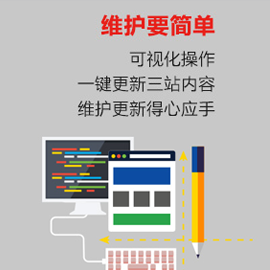android實(shí)用技巧:android實(shí)現(xiàn)listview異步加載圖片-創(chuàng)新互聯(lián)
針對(duì)listview異步加載圖片這個(gè)問(wèn)題,麥子學(xué)院android開(kāi)發(fā)老師講了一種非常實(shí)用的方法,麥子學(xué)院android開(kāi)發(fā)老師說(shuō)凡是是要通過(guò)網(wǎng)絡(luò)獲取圖片資源一般使用這種方法比較好,用戶體驗(yàn)好,下面就說(shuō)實(shí)現(xiàn)方法,先貼上主方法的代碼:

package cn.wangmeng.test;
import java.io.IOException;
import java.io.InputStream;
import java.lang.ref.SoftReference;
import java.net.MalformedURLException;
import java.net.URL;
import java.util.HashMap;
import android.graphics.drawable.Drawable;
import android.os.Handler;
import android.os.Message;
public class AsyncImageLoader {
private HashMap<String, SoftReference<Drawable>> p_w_picpathCache;
public AsyncImageLoader() {
p_w_picpathCache = new HashMap<String, SoftReference<Drawable>>();
}
public Drawable loadDrawable(final String p_w_picpathUrl, final ImageCallback p_w_picpathCallback) {
if (p_w_picpathCache.containsKey(p_w_picpathUrl)) {
SoftReference<Drawable> softReference = p_w_picpathCache.get(p_w_picpathUrl);
Drawable drawable = softReference.get();
if (drawable != null) {
return drawable;
}
}
final Handler handler = new Handler() {
public void handleMessage(Message message) {
p_w_picpathCallback.p_w_picpathLoaded((Drawable) message.obj, p_w_picpathUrl);
}
};
new Thread() {
@Override
public void run() {
Drawable drawable = loadImageFromUrl(p_w_picpathUrl);
p_w_picpathCache.put(p_w_picpathUrl, new SoftReference<Drawable>(drawable));
Message message = handler.obtainMessage(0, drawable);
handler.sendMessage(message);
}
}.start();
return null;
}
public static Drawable loadImageFromUrl(String url) {
URL m;
InputStream i = null;
try {
m = new URL(url);
i = (InputStream) m.getContent();
} catch (MalformedURLException e1) {
e1.printStackTrace();
} catch (IOException e) {
e.printStackTrace();
}
Drawable d = Drawable.createFromStream(i, "src");
return d;
}
public interface ImageCallback {
public void p_w_picpathLoaded(Drawable p_w_picpathDrawable, String p_w_picpathUrl);
}
}
以上代碼是實(shí)現(xiàn)異步獲取圖片的主方法,SoftReference是軟引用,是為了更好的為了系統(tǒng)回收變量,重復(fù)的URL直接返回已有的資源,實(shí)現(xiàn)回調(diào)函數(shù),讓數(shù)據(jù)成功后,更新到UI線程。
幾個(gè)輔助類(lèi)文件:
package cn.wangmeng.test;
public class ImageAndText {
private String p_w_picpathUrl;
private String text;
public ImageAndText(String p_w_picpathUrl, String text) {
this.p_w_picpathUrl = p_w_picpathUrl;
this.text = text;
}
public String getImageUrl() {
return p_w_picpathUrl;
}
public String getText() {
return text;
}
}
package cn.wangmeng.test;
import android.view.View;
import android.widget.ImageView;
import android.widget.TextView;
public class ViewCache {
private View baseView;
private TextView textView;
private ImageView p_w_picpathView;
public ViewCache(View baseView) {
this.baseView = baseView;
}
public TextView getTextView() {
if (textView == null) {
textView = (TextView) baseView.findViewById(R.id.text);
}
return textView;
}
public ImageView getImageView() {
if (p_w_picpathView == null) {
p_w_picpathView = (ImageView) baseView.findViewById(R.id.p_w_picpath);
}
return p_w_picpathView;
}
}
ViewCache是輔助獲取adapter的子元素布局
package cn.wangmeng.test;
import java.util.List;
import cn.wangmeng.test.AsyncImageLoader.ImageCallback;
import android.app.Activity;
import android.graphics.drawable.Drawable;
import android.view.LayoutInflater;
import android.view.View;
import android.view.ViewGroup;
import android.widget.ArrayAdapter;
import android.widget.ImageView;
import android.widget.ListView;
import android.widget.TextView;
public class ImageAndTextListAdapter extends ArrayAdapter<ImageAndText> {
private ListView listView;
private AsyncImageLoader asyncImageLoader;
public ImageAndTextListAdapter(Activity activity, List<ImageAndText> p_w_picpathAndTexts, ListView listView) {
super(activity, 0, p_w_picpathAndTexts);
this.listView = listView;
asyncImageLoader = new AsyncImageLoader();
}
public View getView(int position, View convertView, ViewGroup parent) {
Activity activity = (Activity) getContext();
// Inflate the views from XML
View rowView = convertView;
ViewCache viewCache;
if (rowView == null) {
LayoutInflater inflater = activity.getLayoutInflater();
rowView = inflater.inflate(R.layout.p_w_picpath_and_text_row, null);
viewCache = new ViewCache(rowView);
rowView.setTag(viewCache);
} else {
viewCache = (ViewCache) rowView.getTag();
}
ImageAndText p_w_picpathAndText = getItem(position);
// Load the p_w_picpath and set it on the ImageView
String p_w_picpathUrl = p_w_picpathAndText.getImageUrl();
ImageView p_w_picpathView = viewCache.getImageView();
p_w_picpathView.setTag(p_w_picpathUrl);
Drawable cachedImage = asyncImageLoader.loadDrawable(p_w_picpathUrl, new ImageCallback() {
public void p_w_picpathLoaded(Drawable p_w_picpathDrawable, String p_w_picpathUrl) {
ImageView p_w_picpathViewByTag = (ImageView) listView.findViewWithTag(p_w_picpathUrl);
if (p_w_picpathViewByTag != null) {
p_w_picpathViewByTag.setImageDrawable(p_w_picpathDrawable);
}
}
});
if (cachedImage == null) {
p_w_picpathView.setImageResource(R.drawable.default_p_w_picpath);
}else{
p_w_picpathView.setImageDrawable(cachedImage);
}
// Set the text on the TextView
TextView textView = viewCache.getTextView();
textView.setText(p_w_picpathAndText.getText());
return rowView;
}
}
ImageAndTextListAdapter是實(shí)現(xiàn)ListView的Adapter,里面有個(gè)技巧就是p_w_picpathView.setTag(p_w_picpathUrl),setTag是存儲(chǔ)數(shù)據(jù)的,這樣是為了保證在回調(diào)函數(shù)時(shí),listview去更新自己對(duì)應(yīng)item,大家仔細(xì)閱讀就知道了。
最后貼出布局文件:
<?xml version="1.0" encoding="utf-8"?>
<LinearLayout xmlns:android="http://schemas.android.com/apk/res/android"
android:orientation="horizontal"
android:layout_width="fill_parent"
android:layout_height="wrap_content">
<ImageView android:id="@+id/p_w_picpath"
android:layout_width="wrap_content"
android:layout_height="wrap_content"
/>
<TextView android:id="@+id/text"
android:layout_width="wrap_content"
android:layout_height="wrap_content"/>
</LinearLayout>
另外有需要云服務(wù)器可以了解下創(chuàng)新互聯(lián)scvps.cn,海內(nèi)外云服務(wù)器15元起步,三天無(wú)理由+7*72小時(shí)售后在線,公司持有idc許可證,提供“云服務(wù)器、裸金屬服務(wù)器、高防服務(wù)器、香港服務(wù)器、美國(guó)服務(wù)器、虛擬主機(jī)、免備案服務(wù)器”等云主機(jī)租用服務(wù)以及企業(yè)上云的綜合解決方案,具有“安全穩(wěn)定、簡(jiǎn)單易用、服務(wù)可用性高、性價(jià)比高”等特點(diǎn)與優(yōu)勢(shì),專(zhuān)為企業(yè)上云打造定制,能夠滿足用戶豐富、多元化的應(yīng)用場(chǎng)景需求。
標(biāo)題名稱:android實(shí)用技巧:android實(shí)現(xiàn)listview異步加載圖片-創(chuàng)新互聯(lián)
分享地址:http://www.chinadenli.net/article2/dgegic.html
成都網(wǎng)站建設(shè)公司_創(chuàng)新互聯(lián),為您提供微信小程序、微信公眾號(hào)、網(wǎng)站建設(shè)、外貿(mào)網(wǎng)站建設(shè)、云服務(wù)器、虛擬主機(jī)
聲明:本網(wǎng)站發(fā)布的內(nèi)容(圖片、視頻和文字)以用戶投稿、用戶轉(zhuǎn)載內(nèi)容為主,如果涉及侵權(quán)請(qǐng)盡快告知,我們將會(huì)在第一時(shí)間刪除。文章觀點(diǎn)不代表本網(wǎng)站立場(chǎng),如需處理請(qǐng)聯(lián)系客服。電話:028-86922220;郵箱:631063699@qq.com。內(nèi)容未經(jīng)允許不得轉(zhuǎn)載,或轉(zhuǎn)載時(shí)需注明來(lái)源: 創(chuàng)新互聯(lián)
猜你還喜歡下面的內(nèi)容
- hadoop0.20.2完全分布式環(huán)境搭建-創(chuàng)新互聯(lián)
- slot怎么在vue項(xiàng)目中使用-創(chuàng)新互聯(lián)
- WondershareRecoveritforMac軟件有哪些功能-創(chuàng)新互聯(lián)
- Azure中部署Sqlserver網(wǎng)絡(luò)無(wú)法訪問(wèn)如何解決-創(chuàng)新互聯(lián)
- SAPOData服務(wù)性能測(cè)量的工具和手段有哪些-創(chuàng)新互聯(lián)
- 使用python3中hasattr函數(shù)的方法-創(chuàng)新互聯(lián)
- Win7修改密碼策略設(shè)置雙重密碼-創(chuàng)新互聯(lián)

- 小程序?qū)徍松?jí),代碼也需審核_微信小程序教程 2021-10-18
- 微信小程序開(kāi)發(fā)和APP開(kāi)發(fā)有哪些區(qū)別? 2022-07-04
- 微信小程序的推廣方法都有哪些? 2022-05-15
- 微信小程序都有哪些推廣方式可選 2022-08-16
- 成都微信小程序開(kāi)發(fā)方案報(bào)價(jià) 2014-06-29
- 看病,很煩?一個(gè)微信小程序搞定! 2022-05-24
- 我們是不是真的需要微信小程序? 2022-06-01
- 如何玩轉(zhuǎn)微信小程序 2021-10-27
- 需要微信小程序開(kāi)發(fā)制作費(fèi)用報(bào)價(jià),制作小程序開(kāi)發(fā)要花多少錢(qián)? 2022-07-15
- 餐飲行業(yè)微信小程序,公眾號(hào)開(kāi)發(fā)解決方案 2021-01-05
- 微信應(yīng)用與微信小程序出現(xiàn)的原因 2022-07-13
- 微信小程序如何制作 方法有哪些 2020-10-30